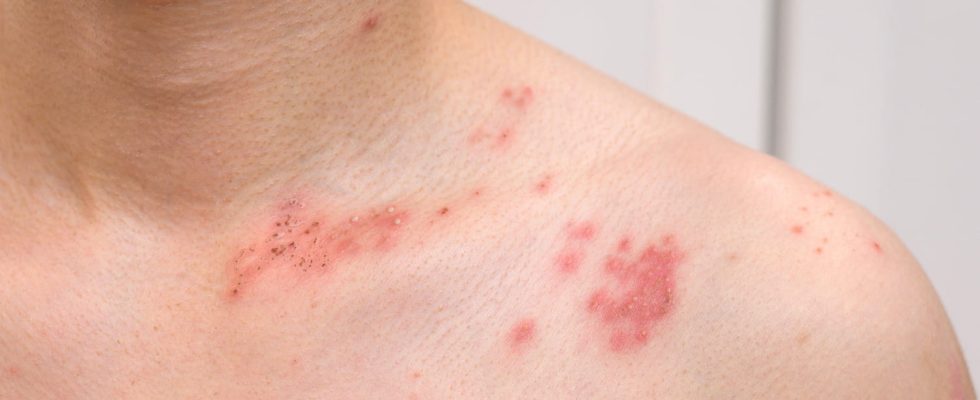Painful, tiring, long… Shingles is a skin condition that flattens the body. Why do we catch it? How to treat yourself? Advice with our dermatologist.
Shingles is a infectious disease linked to a new contact with the virus that causes chickenpoxcommonly called the VZV. “Years after chickenpox, the same virus can re-infect the weakened body and colonize a nervous area in the skin“, explains Dr Jean-Luc Rigon, dermatologist-venerologist. The virus can spread through the nerves towards the skin and mucous membranes where it creates vesicles similar to those of chickenpox. “Shingles appears on a very limited nervous territory; its manifestations are most of the time localized on only one side of the body“, specifies the specialist. Knowing that “some areas are more dangerous than others, such as face or eye ; the consequences can be more serious“. Reactivation of the virus can occur mainly in the elderly or during a reduction of the body’s defenses. Shingles can affect different areasdepending on the nervous territory attacked.
► Intercostal zone. It is the most common shingles, called “the ring of fire”. A nerve located at the level of the spine is infected, which causes symptoms to appear in the innervated area, on only one side of the thorax : we are talking about a semi-belt eruption between 2 ribs. “This shingles progresses in two or three weeks, it is often benign“, reassures the dermatologist. Less common, abdominal shingles develops in the abdomen, with a less clear form.
► Shingles ophthalmicus (eyes). It’s about a rare and potentially serious form of shingles. The disease manifests itself as sharp pain on one side of the face followed by a rash and burns in the eyelids and eyes. “This shingles can be responsible for loss of vision due to corneal opacification and must be treated urgently“.
► Shingles of the face (facial). Classically, it is shingles, which appears on one side of the face. It corresponds to damage to one of the 3 branches of the trigeminal nerve responsible for facial sensitivity.
► Ear shingles (ear). When he reaches the nerve of Wrisberg, shingles is called ear or otitis and causes specific symptoms: ear pain, loss of sensitivity of the tongue and sometimes dizziness or hearing problems associated with facial paralysis. “It is a rarer and difficult to diagnose shingles, because it only affects part of the ear canal“.
To know that nine out of ten adults in the world have already contracted the chickenpox virus and therefore carry the VZV virus. Among these people, it is estimated that a small number will one day be affected by shingles. THE virus is reactivated when immune defenses decline. This may be due stress or a benign or chronic illness such as cancer. “During the flu epidemics, for example, we may be more vulnerable“, adds Jean-Luc Rigon.
What are the symptoms of shingles?
“Shingles is a burn“, summarizes Dr. Rigon. As such, the warning signs of a shingles outbreak are often characteristic:
- tingling sensation
- burning sensation
- skin rashes (wheals). It is small blister-like vesicles filled with pus localized along the path of a sensory nerve. After a few days, these vesicles dry up and form crusts which eventually fall off. This cycle can last between 2 and 4 weeks, during which we generally observe 2 or 3 flare-ups.
- of the after-effect pain often very inconvenient, called post-herpetic pain. “Elderly people in particular suffer from chronic neuralgia, a pain similar to an electric shock which can cause a lot of discomfort – depression, sleep disorders, etc.“.
Is shingles contagious?
A person who has already had chickenpox will not be able to contract shingles from a person who herself suffers from shingles. On the other hand, the virus can be transmitted to a person who has never contracted chickenpox. The fluid present in the vesicles contains VZV; if this vesicular fluid comes into contact with the mucous membranes of a non-immune person, he could contaminate it. “But the risk is low, since almost everyone has had chickenpox before.“, points out Jean-Luc Rigon.
There is no risk of contagion from one area to another in the same person: intercostal shingles will not generate ophthalmic shingles, but good hygiene must be adopted. “Having intercostal shingles, scratching yourself, then putting on your contact lenses without washing your hands is a guaranteed disaster! You can easily get an infected eye. Antiseptics and occlusive dressings are used to avoid the risk of secondary infection.“, recommends Dr. Rigon.
THE local treatments make it possible to avoid bacterial superinfection of the vesicles. The use of a dermatological soap and the application oflocal antiseptics are recommended, as well as wearing an occlusive dressing. “You must also adopt hygiene measures, wash your hands regularly“, advises Dr. Rigon. Pain can be treated with analgesics such as paracetamol. Of the antiviral treatments (valaciclovir) can be prescribed but they must be taken within the first 3 days following the appearance of the first lesions, otherwise they are ineffective. Finally, “vaccines exist against VZV, but they are only reimbursed by Social Security for people over 65 years olddue to the increased risk of complications“. As for people suffering from post-herpetic pain, “they often need to be treated in centers specializing in the treatment of pain“, concludes the dermatologist.
Thanks to Dr Jean-Luc Rigon, venereologist dermatologist in Nancy (Meurthe-et-Moselle).

